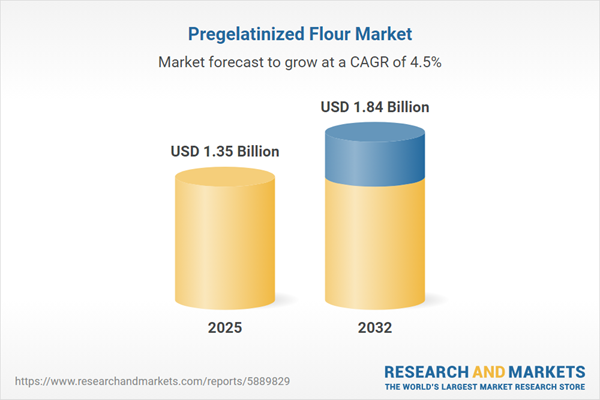Speak directly to the analyst to clarify any post sales queries you may have.
The pregelatinized flour market is in transition, requiring leaders to balance regulatory compliance, operational transparency, and resilience. Organizations navigating this sector must anticipate customer preferences and evolving standards to strengthen market positioning and sustain growth.
Pregelatinized Flour Market Snapshot
In 2024, the pregelatinized flour market is valued at USD 1.29 billion with projections to reach USD 1.35 billion by 2025 and a sustained CAGR of 4.50% through 2032. Market growth is fueled by consistent demand across food manufacturing, animal nutrition, pharmaceuticals, and personal care sectors. The push for clean label ingredients remains a critical factor, as does the versatility required for a wide array of functional applications. Manufacturers continue to prioritize advanced processing methods and enhanced quality assurance to keep pace with regulatory shifts and growing customer expectations. Focusing on agile production and adaptive formulations supports businesses facing changing global and regional market dynamics.
Scope & Segmentation in the Pregelatinized Flour Market
- Form: Market offerings include both granule and powder formats, allowing buyers to select products tailored to their operational processes or the needs of specific end-use sectors. This flexibility supports efficient supply chain management and customization.
- Distribution Channel: Channels span supermarkets, specialty retailers, grocery outlets, pharmacies, and e-commerce platforms. A broad presence meets diverse industry procurement strategies and highlights the importance of reliable supply access.
- Application: Pregelatinized flour is used in cosmetics, animal feed, bakery, dairy, beverages, confectionery, protein fortification, desserts, and pharmaceuticals. Each application segment demands precise functionality and stable performance from suppliers.
- Source: Principal raw materials include cassava, potato, corn, and tapioca. These cater to buyers seeking gluten-free or non-GMO options and align with emerging dietary and consumer trends.
- Regions Covered: The market spans the Americas, Europe, Middle East & Africa, and Asia-Pacific. Each region presents different regulatory landscapes, adoption patterns, and innovation drivers, making localized strategies crucial for success.
- Companies Analyzed: The report features profiles of Archer Daniels Midland Company, Cargill, Ingredion Incorporated, Tate & Lyle PLC, Roquette Frères, Grain Processing Corporation, American Key Products, Avebe U.A., AGRANA Beteiligungs-AG, and Tereos S.A. Analysis centers on sector advancements and steady supply capabilities.
- Technologies: Production relies on extrusion, drum drying, and continuous drying. Adoption of digital and cloud-based quality management systems is increasing, enhancing product traceability and supporting compliance management across supply chains.
Pregelatinized Flour Market: Key Takeaways for Senior Decision Makers
- Adopting clean label initiatives enhances transparency and positions organizations for future regulatory compliance in major application sectors.
- Strengthening collaboration with suppliers and manufacturing partners supports responsiveness to fast-changing customer needs and compliance requirements.
- Expanding omnichannel distribution channels, both physical and digital, widens access for industry buyers and aligns with changing procurement behaviors.
- Deploying digital quality control systems introduces uniformity and enables prompt adaptation to evolving standards across different regulatory environments.
- Enhancing ingredient sourcing diversity increases supply chain resilience and enables swift response to adjustments in labeling or dietary regulations.
Tariff Impact on Market Strategy
Changing tariff landscapes, especially in the United States, require companies to continuously revisit supplier relationships and sourcing approaches. Focus on local procurement and domestic production has become essential to maintaining operational resilience and efficiency during economic disruptions.
Methodology & Data Sources
This research combines direct interviews with manufacturers, distributors, and end-users, with in-depth reviews of supply chain frameworks, industry journals, and regulatory materials. The resulting analysis equips stakeholders with practical data to guide effective business planning.
Why This Report Matters
- Equips senior leaders with strategies to adapt business models as compliance standards and sourcing requirements shift across regions and sectors.
- Delivers detailed segmentation and application insights to support informed market entry decisions and targeted risk management.
- Assists organizations in maintaining agility when facing changes in regulatory environments and evolving customer expectations.
Conclusion
Achieving sustainable progress in the pregelatinized flour sector demands a focus on compliance, process innovation, and solid supply partnerships. This analysis enables informed strategic choices for leaders committed to resilience and long-term operational growth.
Additional Product Information:
- Purchase of this report includes 1 year online access with quarterly updates.
- This report can be updated on request. Please contact our Customer Experience team using the Ask a Question widget on our website.
Table of Contents
3. Executive Summary
4. Market Overview
7. Cumulative Impact of Artificial Intelligence 2025
Companies Mentioned
The companies profiled in this Pregelatinized Flour market report include:- Archer Daniels Midland Company
- Cargill, Incorporated
- Ingredion Incorporated
- Tate & Lyle PLC
- Roquette Frères
- Grain Processing Corporation
- American Key Products, Inc.
- Avebe U.A.
- AGRANA Beteiligungs-AG
- Tereos S.A.
Table Information
| Report Attribute | Details |
|---|---|
| No. of Pages | 194 |
| Published | November 2025 |
| Forecast Period | 2025 - 2032 |
| Estimated Market Value ( USD | $ 1.35 Billion |
| Forecasted Market Value ( USD | $ 1.84 Billion |
| Compound Annual Growth Rate | 4.5% |
| Regions Covered | Global |
| No. of Companies Mentioned | 11 |









